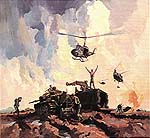Recovery in The Field - 1944

Page 6
Job 7 .. Positive Tow

The Covenanter tank in Fig27 has a damaged sprocket and idler and therefore cannot be steered for towing purposes. The method of recovery in these circumstances is to shorten the tracks over the bogie wheels as indicated, and to use a Hollebone draw bar direct coupled to a 6-wheeled Scammell breakdown tractor, so providing a positive tow and prevent the casualty from swinging from side to side.
The tractor is itself fitted with overall tracks over the two pairs of rear wheels for traversing the difficult ground.
Job 8 .. Scammell Tractors on Recovery


Although not shown in the illustration, another Scammell tractor is used for the recovery of the 16 ton Valentine tank from the deep bog as illustrated in Fig28.
With an estimated pull of 18 tons, calculated from the rolling and grade resistances, this calls for a 3 to 1 reduction ratio, the layout and equipment for which is depicted in the graphical drawing Fig29.
Job 8



Our last example of Scammell tractor recovery features the use of a 9 to 1 compound reduction layout on the very difficult job of recovering a 25ton Matilda tank over a steep bank from a deep bog as illustrated in Fig30. As will be seen, the bank is of very soft ground and although digging has been carried out, the nose continues to bury itself in the earth as the pull continues.
The first pull was estimated at approximately 42 tons, owing to its immersed condition and the steepness of the slope up which the tank has to be pulled, necessitating the use of a 6-1 compound reduction ratio layout (shown at `A' in the drawing Fig32).
However, when pulling out the tank it was seen that the spare length of rope employed would require to be shortened before the tank was brought to the top of the bank.
It was then decided that rather than pull up the earth anchors and relay, to use a further snatch block for the spare rope to pass around, so compounding a simple 3 to 1 reduction ratio by a 3 to 1, making a 9 to 1 compound reduction ratio as shown at `B' in Fig32. The layout is also shown pictorially in Fig31.


